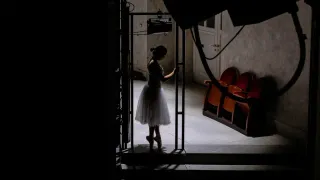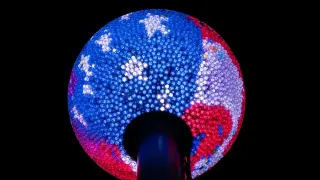February 10, 2024
How a Run-Down Ford Launched a Music Revolution that swept Brazil's Carnival
David Biller READ TIME: 4 MIN.
Sound begins blasting ear drums and rattling bones even before the speakers – hauled by big rigs creeping their way through Brazil's thronging Carnival crowds – draw near.
The behemoth sound trucks known as electric trios are a Brazilian innovation that amplified music and effectively did away with front-row seats – making Carnival more accessible. In the seven decades since the first one hit Brazil's streets, they have become a fixture of the country's annual pre-Lenten festivities and draw millions to the streets. Singer Caetano Veloso's ode to the earth-shaking vehicles proclaimed that the only people not following them must already be dead.
From Salvador, on Brazil's northeast coast, trios spread throughout the country and found more disciples; an Instagram account that posts seemingly banal videos of the nation's rigs has about 150,000 followers, with fans praising each trio's merits. They've grown ever more sophisticated and ever larger – with lights, LED screens, dressing rooms and VIP areas.
Their appeal has never been just the novelty of amplification. Their steady, constant advance meant anyone, rich or poor, could get close enough to the music to feel it throb through their body, said Isaac Edington, who coordinates Salvador's festivities as president of its tourism agency.
Helen Salgado, a 31-year-old actress, traveled to Salvador from Rio to immerse herself in the oceans of people churning around trios in celebrations ahead of the official start of Carnival on Saturday. She said she was driven to ecstasy without consuming so much as a drop of alcohol.
"It was very loud ... and marvelous!" Salgado said by phone, laughing. "I think that's why there's all this frenzy: The sound dominates you and intoxicates you."
But long before these walls of sound took Brazil by storm, there was a Ford.
It was a 1929 Model A – the Model T's lesser-known successor – imported from the U.S. to Salvador. For years, metalworker Osmar Macedo used the convertible to haul iron.
In 1950, Osmar, as he is universally known, and his friend Dodô, a radio technician and fellow amateur musician, outfitted the Ford with two speakers and connected their guitar and cavaquinho to the car's battery, Aroldo Macedo, Osmar's son, told The Associated Press. They drove the car, with its dented fender and chipping maroon paint, through the streets playing music and delighting Carnival revelers who jumped and jived in their wake, said Macedo, 65.
The duo repeated the stunt the next year, this time with a third musician, and so called themselves the Trio Eletrico.
The term stuck, and was applied to all mobile stages that rolled across Salvador, the capital of Bahia state. Soon enough, trios were the centerpiece of the city's Carnival.
They started featuring Bahia's top artists, like Veloso, who clambered aboard one built specially for him in 1972 that resembled a spaceship. They became launchpads for the careers of musicians, including Daniela Mercury, Ivete Sangalo and Margareth Menezes, Brazil's current culture minister, who called the trio "one of Brazil's great inventions."
"It was a great revolution in the Carnival of the people, the Carnival of the street," Menezes said by phone from Salvador, where she's preparing the Trio of Culture that will feature herself alongside Gilberto Gil and Chico César. "Everyone wants to shake themselves to the sound of the electric trio."
That popular spirit is at the heart of Carnival, which isn't just about cutting loose; it also represents the subversion of established order and roving street parties are a manifestation of the people taking control of the city.
Salvador's trios were a guiding light for Rio when street parties reemerged after Brazil cast off its military dictatorship in 1985, according to Rita Fernandes, president of the Sebastiana association that organizes some of the city's most traditional parties.
Rick Mello's Rick Sound provides trios for more than two dozen street parties in Rio and also rents the trucks to samba schools rehearsing for the traditional Sambadrome parade. There were 11 trios shoehorned into his warehouse in January – and he says he can't run full sound tests inside because the clamor, reaching up to 180 decibels, could blow out an eardrum.
"Compared to Bahia, this is a Volkswagen Beetle," Mello said, referring to his biggest truck, which has 60 speakers. "But one day we'll get there."
Perhaps the best known of all the trios was the Dragon. Salvador-based band Asa de Aguia (Eagle's Wing) performed atop the truck for years and immortalized it in a song as "the biggest electric trio on the planet."
But the Dragon was a handful. Its 30-meter (98-foot) length made cornering a feat, and at 5.5 meters (18 feet) tall, it often snagged power lines and toppled utility poles when touring to Rio or Sao Paulo for gigs, according to José Mario Bordonal, whose company bought it a decade ago.
Bordonal and his siblings founded their company to build sound trucks in their tiny hometown in Sao Paulo's rural interior, Cravinhos.
Their first trio upset the order of things about 35 years ago, with a wild street party for the working class that lured even the well-heeled to forgo a private Carnival soiree, Bordonal said. The police, and the soiree's organizer, were furious.
Roughly a quarter-century later, the Dragon caused fresh ruckus.
"When it got to Cravinhos ... it entered the first street, and it pulled down two poles right away," Bordonal said.
He modified the Dragon's axles to make cornering easier and reduced its height – but extended its length to 34 meters (111 feet). Bordonal eventually sold it, and has since built a bigger trio whose 200 speakers blasted Sao Paulo's biggest street party of the Carnival season on Feb. 4 – and he has plans for an even larger one.
But Salvador's vast fleet makes it the unrivaled kingdom. During Carnival this year, as many as 70 will plod through the swarming crowds each day, Edington said. Rio has roughly that amount through all of Carnival, according to its tourism agency.
In a tribute to the trios' forebears, Salvador's two main trio routes are named for Osmar and Dodô, and a replica of their Ford appears atop one of the mammoth rigs.
Coming full circle from the imported Ford that became Brazil's first trio, singer Claudia Leitte is in the process of dispatching a trio to the U.S.
Leitte, who once sang atop a trio for seven hours straight, intends to bring a Salvador-style Carnival to Miami's Ocean Drive.






